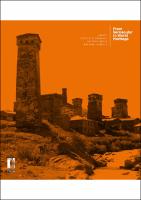From Vernacular to World Heritage
| dc.contributor.editor | Dipasquale, Letizia | |
| dc.contributor.editor | Mecca, Saverio | |
| dc.contributor.editor | Correia, Mariana | |
| dc.date.accessioned | 2022-05-31T10:34:10Z | |
| dc.date.available | 2022-05-31T10:34:10Z | |
| dc.date.issued | 2020 | |
| dc.identifier | ONIX_20220531_9788855182935_864 | |
| dc.identifier | OCN: 1326063865 | |
| dc.identifier.uri | https://library.oapen.org/handle/20.500.12657/55580 | |
| dc.description.abstract | This publication brings together the results of the project 3DPAST: Living and virtual visiting European World Heritage, co-funded by the Creative Europe EU programme. The research highlighted the exceptional character and quality of living in vernacular dwellings found in World Heritage sites. This was possible by seizing the cultural space of European vernacular heritage, located in Pico island (Portugal), Cuenca town (Spain), Pienza (Italy), Old Rauma (Finland), Transylvania (Romania), Berat & Gjirokastra (Albania), Pátmos (Greece), and Upper Svaneti (Georgia). New digital realities grant the possibility to visit and to appreciate those places, to non-travelling audiences, who lack the opportunity to experience this unique heritage in situ. Creative potential is highlighted in 3D models and digital visualisations, which associate outstanding local knowledge with the vernacular expression of World Heritage. | |
| dc.language | English | |
| dc.relation.ispartofseries | Ricerche. Architettura, Pianificazione, Paesaggio, Design | |
| dc.subject.other | Vernacular Architecture | |
| dc.subject.other | World Heritage Management | |
| dc.subject.other | Virtual Heritage | |
| dc.subject.other | Intangible Heritage | |
| dc.subject.other | Cultural Landscape | |
| dc.title | From Vernacular to World Heritage | |
| dc.type | book | |
| oapen.identifier.doi | 10.36253/978-88-5518-293-5 | |
| oapen.relation.isPublishedBy | bf65d21a-78e5-4ba2-983a-dbfa90962870 | |
| oapen.relation.isbn | 9788855182935 | |
| oapen.relation.isbn | 9788855182546 | |
| oapen.relation.isbn | 9788855182928 | |
| oapen.series.number | 5 | |
| oapen.pages | 240 | |
| oapen.place.publication | Florence |

